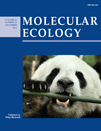On the spatial scale of dispersal in coral reef fishes
Abstract
Marine biologists have gone through a paradigm shift, from the assumption that marinepopulations are largely ‘open’ owing to extensive larval dispersal to the realization that marine dispersal is ‘more restricted than previously thought’. Yet, population genetic studies often reveal low levels of genetic structure across large geographic areas. On the other side, more direct approaches such as mark-recapture provide evidence of localized dispersal. To what extent can direct and indirect studies of marine dispersal be reconciled? One approach consists in applying genetic methods that have been validated with direct estimates of dispersal. Here, we use such an approach—genetic isolation by distance between individuals in continuous populations—to estimate the spatial scale of dispersal in five species of coral reef fish presenting low levels of genetic structure across the Caribbean. Individuals were sampled continuously along a 220-km transect following the Mesoamerican Barrier Reef, population densities were estimated from surveys covering 17 200 m2 of reef, and samples were genotyped at a total of 58 microsatellite loci. A small but positive isolation-by-distance slope was observed in the five species, providing mean parent-offspring dispersal estimates ranging between 7 and 42 km (CI 1–113 km) and suggesting that there might be a correlation between minimum/maximum pelagic larval duration and dispersal in coral reef fishes. Coalescent-based simulations indicate that these results are robust to a variety of dispersal distributions and sampling designs. We conclude that low levels of genetic structure across large geographic areas are not necessarily indicative of extensive dispersal at ecological timescales.

